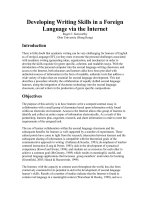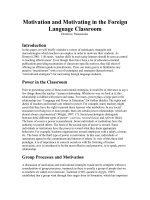Team Teaching Tips for Foreign Language Teachers
Bạn đang xem bản rút gọn của tài liệu. Xem và tải ngay bản đầy đủ của tài liệu tại đây (84.26 KB, 8 trang )
Team Teaching Tips for Foreign Language
Teachers
Introduction
This article seeks to provide team teachers with specific tips on how to function effectively
as equal partners working together in the same classroom. These step-by-step tips are a
basic guide to help you establish a dynamic team so you can experiment and find the
approach that works best for you. For teachers who have never had a chance to team teach,
or have perhaps avoided doing it for a variety of reasons, perhaps this article will help allay
fears and give teachers a sense of what exactly team teaching 'looks like' within the class.
From our work team teaching with one another and others in a variety of contexts
(elementary, high school, junior high school, and international schools) in Canada, Mexico
and Japan, we've had the chance to experience everything from wonderful to disastrous
team teaching relationships. Based on these experiences, we have assembled a brief series
of tips to help you and your classroom partner.
Background Literature
Team teaching, in the most general sense, encompasses a wide variety of arrangements.
One specific form, which has become quite prevalent in recent years, is having two
teachers in the classroom teaching simultaneously. This is becoming more and more
common throughout Japan and in other Asian countries. Each year on the Japan Exchange
and Teaching (JET) Programme alone, nearly 6,000 Assistant Language Teachers (ALT)
come to Japan to assist Japanese Language Teachers (JLT) in foreign language classrooms
(Horwich par. 22). Recently, Hong Kong launched a programme similar to JET called the
Native-speaking English Teachers Programme (NET) Programme that also employs team
teaching.
In foreign language teaching, particularly teaching English as a foreign language (TEFL),
usually one in the pair is a native speaking assistant of the target language. We’ll use the
acronym NSA (native speaking assistant) to describe these teachers. The main teacher on
the other hand, is usually more experienced and not a native speaker of the target language
(hence the desire for a native speaking target language assistant). These teachers will be
referred to as NNSLT (non-native speaking language teachers).
In some countries where the target language (in this case English) is a second language
(TESL), student teachers are native speakers of the target language and work either with
other student teachers or cooperative teachers. These pairs share the same L1, are native
speakers of the target language and share the same culture as their partner. These pairs
usually do not experience the intercultural difficulties that some TEFL teachers experience
and since they are in the process of becoming certified (in the case of student teachers), do
not necessarily experience the same conflicts that some JTE/AET or HKTE/NET
experience in Japan or Hong Kong and elsewhere.
One of the advantages of team teaching is that it ostensibly produces a lower teacher-
student ratio, but having two teachers in the class sharing turns speaking does not
accomplish this. Only by running separate activities, dividing the class into groups - having
both teachers circulate and interact with students is the ratio effectively lowered. Ideally,
both teachers should constantly be actively involved in managing and teaching the class.
Aside from these government sponsored programmes, there are countless others which are
privately organised also resulting in the presence of a second teacher in the classroom.
Team teaching is most common in the domain of foreign language education, but is also
starting to be used in a variety of other subject areas. It is a pedagogical approach rapidly
gaining in popularity.
Successful team teaching has the potential to benefit all concerned. Teachers stand to gain
in terms of their professional development. Team teaching provides teachers with a partner
to help them set objectives, make plans, implement lessons and evaluate the results. They
have someone from whom they can draw inspiration and who can provide them with
constructive feedback on their teaching. Students benefit from the increased quality of the
lessons and a lower student to teacher ratio.
Unfortunately, most teachers destined to work together do so with little training in how to
team teach. For example, in Japan most training is done by observation of team teaching
lessons with little analysis of the strategies/techniques employed by the team, often leaving
Japanese Teachers of English nervous about team teaching.
Horwich explains that this lack of training can lead to friction between team teachers and
unsuccessful lessons (par. 18). Browne and Evans similarly explain that: "Unfortunately,
the implementation of team teaching to date often seems haphazard and lacking in clear
objectives. Assistant Language Teachers (ALTs), Japanese Teachers of English (JTEs) and
students seem to have different expectations about the purpose of team taught lessons, with
the result often being unsuccessful lessons" (17).
Many teachers refuse to team teach because in a sense, teachers are by definition 'solitary
creatures' reluctant to share the limelight or 'be observed' by a colleague. However, in a
successful team you should not feel judged or upstaged by your partner. Furthermore, in
some situations teachers may not have been given a choice to work together and may not
see the benefits of team teaching, or worse, not respect or get along well with their assigned
partner.
Horwich, in a survey of 141 Japanese Teachers of English in Ibaraki Prefecture (Japan) in
1999, found that only 56% were "satisfied with their team teaching" (par. 12). Since using
two teachers in the same classroom simultaneously is a relatively new educational
phenomenon, it is not easy to find practical advice from senior teachers or professional
publications.
Many articles written about team teaching merely provide lesson plans that demonstrate
which teacher will speak on what topic or lead a particular activity (Wiltshier and Honma
1999). Others discuss the philosophy and history of team teaching exploring the cultural
background and the challenges faced by team teachers from different countries (Shimaoka
and Yashiro; Ministry of Education, Science, Sports and Culture 1994). Unfortunately, few
articles offer practical step-by-step guidelines to establishing a successful team, perhaps
because there is a fear that following a prescriptive formula might in fact restrict the team
and cause them to fall into strict use of fossilized patterns (Smith 87).
In the Classroom: Team Teaching Tips
The Golden Rule: Never take anything for granted; explicitly discuss everything.
"When expectations are unclear or vastly different, this essential rapport quickly breaks
down" (Horwich par.15).
Clear communication on the part of both members of the teaching team is essential to the
success of the relationship and the realisation of your teaching objectives. Communication
is perhaps rendered more difficult for teams made up of teachers from different cultural
backgrounds which value radically different communication styles (Kobayashi 168).
Nonetheless, it is essential that you do your utmost to keep this in mind and endeavour to
respect and understand one another.
Talking things through at every stage will help you define your individual roles within the
team. This is essential in developing a better understanding of one another's teaching
philosophy along with the personal and cultural factors that have shaped it and affect its
practical applications. Honest discussion also clears up any potential misunderstandings
before they have the chance to hamper the flow of a lesson and ensure that you are taking
equal responsibility for staying on course towards your established objectives. These
meetings will help ensure that you are both feeling comfortable and productive within the
team.
Sometimes, despite your best intentions, you have doubts about the strength of your team.
In these situations, frank discussion with departmental management about pair
reassignment, or if this is not possible, problem solving with your assigned teaching partner
and above all maintaining a professional demeanour, may help diffuse potentially
unsatisfactory pairings.
Personal conflicts, whether they are gender-based, cultural or personal have no place within
the classroom. Despite your differences of opinion, each teacher should remain respectful
and professional towards the other in the classroom. Students will be quick to pick up on
any tensions and may try to exploit them. In the classroom, the most important people are
the students: teachers should set aside personal difficulties and make teaching their number
one priority.
Step-by-step Tips: Planning
You first need to work together to analyse your individual strengths and abilities and
determine how these can be used within your team context. Remember to consider what
skills each of you bring to the classroom. For example, is one better at drawing or singing?
Does one of you have better handwriting on the blackboard? Does one of you have more
experience with a particular school setting or group of students? Have one of you worked
with this particular textbook before?
Work out how you complement one another and how you can facilitate improving your
partner's skills in various areas (voice projection and articulation/diction, pacing, giving
instructions, teacher-student interaction etc.). Ideally, both partners will take an active part,
to a greater or lesser extent, in all aspects of the teaching and not fall into a rigid pattern of
acting/teaching only within 'partner 1's domain' and 'partner 2's domain'.
Once you have explored your skill-set as a team, you can begin to set goals for the term
and the year. You'll need to consider what goals both of you want the students to achieve so
that you can plan lessons according to a timetable. If your school sets department-wide
tests, you'll have to discuss goals with the teachers working within the same grade. In
situations like these, homogeneity of teaching approach and materials used is critical to
ensuring fairness to all students.
Making your timetable (of tests, assignments, presentations, homework), setting objectives
together and making sure the other is well aware of the long range agenda, is a wonderful
way of determining what, when and how you can each contribute to the team. It also helps
ensure that your teaching is focused and dynamic. It is difficult to successfully guide
students through a lesson, a chapter, or a term, unless you both know what you will be
exploring along the way and where you want to end up.
Eye Contact and Signalling
Maintaining eye contact with each other is critical in the team teaching classroom. You'll
often need to signal each other for transitions to new activities, communicate when to bring
activities to a close or modify an activity. Try to keep an eye on each other at least every
few minutes. There are often times when Teacher A can 'signal' Teacher B using eye
contact about a situation happening near Teacher A. This is particularly useful for
classroom management, but is also helpful in pacing and for assisting students who may
have questions or need help. In language classrooms where some translation is performed,
maintaining eye contact with your partner is a good way to ensure smooth transitions
between L1 and L2 instructions.
Circulating in the Classroom
One of the benefits of having two teachers in the classroom is that you can increase the
teacher's physical proximity to a greater number of students and thus, hopefully, keep a
greater number of students more actively engaged in the lesson more of the time. It may be
necessary for you both to stand at the front to address the class for various activities, but
this limits the benefits of team teaching's increased teacher-student proximity. It should not
be the main classroom position you adopt in your teaching.
During student-centred activities, it is best for both teachers to circulate at a 180-degree
angle to one another. For example, if teacher A is at the front, teacher B is at the back; if
teacher A is on the left side of the class, teacher B is on the right side. This minimizes the
amount of time it takes for a teacher to address a student concern and maximizes the
supervision provided by the teachers. It is important to watch where the other teacher is in
the classroom and to try to complement their presence.
Individual Roles
In some team teaching pairs, roles in the class can be quite unbalanced. Some NNSLT
provide only L1 translation, while the NSA is largely responsible for most of the target
language 'talking' in the class. In other situations, these NSAs perform as 'live tape-
recorders', undermining student perception of their usefulness in the class (Horwich par.
15).
The NNSLT should be encouraged, as often as possible, to make a concerted effort to use
the target language in the classroom that in turn provides students with a role model who
has successfully learned the target language.
It is best to avoid having one teacher addressing the class, while the other stands idly by. In
the table below we've provided examples of how both teachers can be intensively involved
in team teaching. Both teachers should interchange the roles of 'leader/supporter'
throughout the lesson to ensure equality and responsibility.
Teacher A (leader) Teacher B (supporter)
Explaining an activity
(make eye contact with Teacher B, ask
Teacher B if they have anything to add to the
instructions)
Circulates amongst students keeping them
'on-task', answers student queries.
(Maintain eye contact with Teacher A while
evaluating their instructions and thinking of
something they may have unclear or omitted
that can be restated or added).
Giving students instructions.
Writes the instructions given by Teacher A on
board for visual reinforcement, or, circulates
amongst students to evaluate understanding of
instructions.
Leading choral pronunciation while
circulating in the class.
Echoes Teacher A while circulating which
gives students in all areas of the class a
chance to 'hear' the teacher well.
Evaluating student presentations Administers the activity (calling students,









